30 October 1999
Today was absolutely amazing. Went to the Jewish
cemetery, it was indeed huge, and happened upon a
Catholic cemetery on my way back (I know that I
sound morbid--going to all these cemeteries--but
the history in them is fascinating). I know that
Poland is primarily Catholic and that people paid
tribute to their dead loved ones often throughout
the year, but I never expected ANYTHING like
this. There was a traffic jam in front of the
cemetery. People were lined up 30 deep for the
water faucet to fill the bucket to wash the grave
and tombstone. I walked through the cemetery and
people, entire families (men, women, children and
teenagers included) were having lunch, drinking
coffee, washing the tombstones, decorating the
grave with flowers and branches and ribbons and
candles. Drove to Warsaw early this afternoon. I
found my way through the city quite easily, and
made my way to the Hotel Aldona, otherwise known
as the "boatel." See picture and you
will know why. It was an old boat converted into
a hotel--like most European hotels, the cheaper
option is not to have a bathroom in your room,
and this place was no different. |
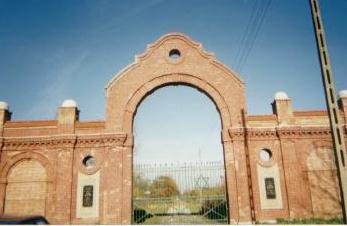
the Jewish cemetery in Lodz,
sadly, fortified due to vandalism |
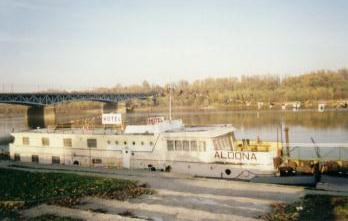
the boatel
|
You had a "stateroom" with bunk
beds, and then at the front of the boat, there
were the bathrooms!! I loved it, and it was only
$10 a night!!! Right on the Wisla River, it was
wonderful. AND, someone was filming a movie on
the river the first night I was there. I looked,
but didn't recognize anyone. Found the nearest
cyber cafe--a MUST on all my out of town trips,
checked my mail, and spent the rest of the
evening walking around Warsaw. |
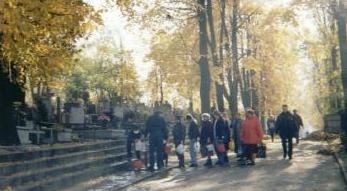
lining up for water at the
cemetery in Lodz
|
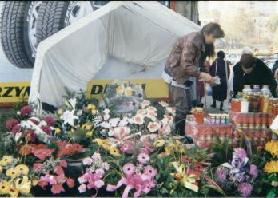
selling flowers in front of the
cemetery |
|
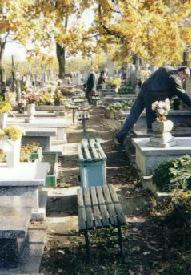
cleaning for the holiday |
|

every plot looked like this!!! |

the Warsaw "House of
Culture"! a monument to Communism
(natives call it the "wedding cake")
|
31 October 1999
Maybe it is because I am Polish, but I feel some
sort of affinity with Warsaw, whatever the
reason, this city, virtually destroyed during
WWII and almost completely rebuilt, is
unbelievably beautiful. I started really early in
the morning, and walked all day until late at
night. I went to the Jewish Ghetto, and saw the
last wall of the ghetto (literally a piece of
brick wall about 30 feet long). I also went to
the Umschlagsplatz, the train platform from which
most of the Jews of the Warsaw ghetto were
deported. They ended up where I had been on
Friday. One of my favorite books when I was
younger was Leon Uris' Mila 18, and I
went to 18 Mila Street (the command center of the
Warsaw Ghetto uprising) and saw the memorial. The
most interesting news, by far, is that I visited
Pawiak Prison--where the Nazis kept and killed
Polish political prisoners (or held them before
deportation to Auschwitz)--and I was looking at
one exhibit, the list of "The Righteous
Among the Nations" (those who helped the
Jews during WWII) and what name should I come
across but "Stanislawa
Werpachowska"!!!!! |
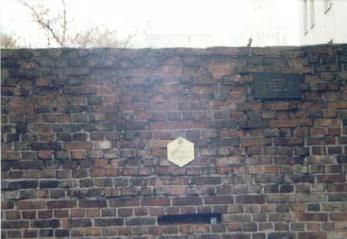
the last wall of the Warsaw Ghetto
|
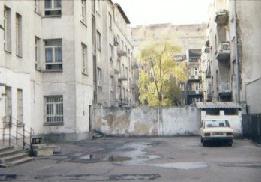
the ghetto wall from the outside
|
I could not believe it. Apparently,
Werpachowski is a very unusual name, even in
Poland. This definitely merits a letter to Yad
Vashem in Israel to find out who this Stanislawa
Werpachowska is/was and why she is so
righteous!!! Definitely one of the highlights of
this year!!!! Warsaw is magnificent. Eighty percent of it
was destroyed in the war, and the Poles rebuilt
it beautifully. Every where there are monuments
to those who fought/died in the Warsaw Uprising.
Warsaw is a WWII buff's heaven! Only after having
been here and experiencing all of this can I
understand how the Communists came to power in
1948. The Red Army liberated many concentration
camps and were instrumental in winning the war in
Europe. Communists were elected widely throughout
Central and Eastern Europe because no one wanted
a government that remotely resembled the fascism
of the Nazis--so they elected the extreme left to
get away from the extreme right. And like a
circle, the two ends/extremes eventually met. Oh
yes, no one celebrates Halloween here, Many, many
people go to church on "All Hallowed's
Eve." As I was walking through the night,
there seemed to be a church at the end of every
block, and the churches were lit, singing was
emanating from within.
|
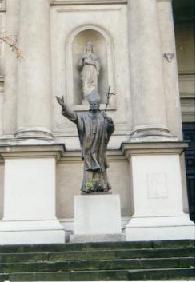
went to mass here: obviously,
Pope John Paul II is very popular here!
|
| There was so much to see, and I walked for
about 13 hours, ending the evening in a tea cafe.
I had to have "Florida tea." I went
back to the boatel, and next door (next boat?)
the movie was still being filmed--on a boat with
ornate 19th century costumes. I walked
over, but didn't see anyone I recognized, and the
cast was speaking Polish, so I guess it is not a
film I will ever see. Very cool, regardless.
Except they filmed until about three in the
morning, loudly and with LOTS of light. one of the many WWII
monuments throughout Warsaw>>
|
 |
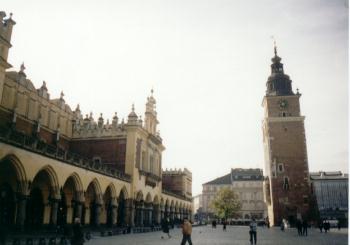
the town center in Krakow
|
1 November 1999
All Saint's Day. Left Warsaw in the morning to
get to Krakow by afternoon. Nothing
in the way of shops was open--it was even hard to
find an open gas station, even though it was
Monday. I have truly never seen anything like it
in my life. In every village, which was every few
kilometers, the police were there to ensure safe
passage of everyone and his and her brother
across the street to the cemetery. I guess the
routine is Mass and then visit the
cemetery--because I was driving from 7 am until 1
pm, from Warsaw to Krakow, and I saw them move
from church to grave all day! I finally made it
to Krakow, but, of course, as is usually my luck,
everything was closed due to the holiday. I
checked into the hotel, and then walked around
the city for a bit, but it was even hard to find
someplace to have a cup of coffee anywhere except
for the main square, as everything was closed in
honor of the holiday. The city is very old and
beautiful, virtually undestroyed, that is, not
bombed, during WWII. Spent the evening reading a
book at a cafe in the square and writing. |

the oldest synagogue in Krakow
|
2 November 1999
On Tuesday, before I had to go home, I went to
the castle, some churches (there are so many!!),
the cathedral at which Pope John Paul II was
archbishop, and of course, the Krakow Ghetto.
Walking through the ghetto and stopping in
synagogues, it completely caught me off guard and
literally knocked the wind out of me--it being
the thought that millions of people were
exterminated and that a thriving community used
to live in these streets, and throughout this
part of Europe, and that they no longer live.
While I was checking my e-mail yesterday, I read
the
history of Slovakia during WWII (something I
had avoided reading thoroughly before I came over
because I didn't want that to cloud my initial
experiences here) on a really good web site and
found out that the president of Slovakia when it
was an "independent" puppet state of
Germany, was a priest who ordered the deportation
of over 70,000 Jews (and no one knows the number
of Roma, or Gypsies) to Auschwitz and other
camps--approximately 80% of the Jewish population
of Slovakia. |

my guide--he didn't speak English,
but we got on well
|
|